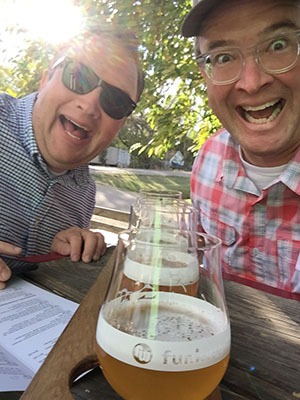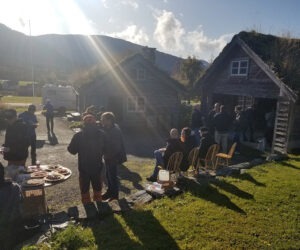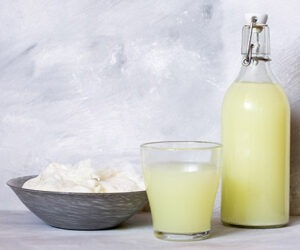Ninkasi Dreams

What a wild ride! The days since winning the Ninkasi — the award for most points in the final round of the National Homebrew Competition — have been an absolute whirlwind. Winning the nation’s largest homebrew award is surreal and one that we never imagined possible.
We started entering competitions regularly about five years ago looking for some unbiased feedback and to see how our beers stacked up against people from the other clubs in Texas. At our local competitions, The Bluebonnet Brewoff and Dixie Cup, we were pleased to receive some almost immediate success. We found that generally our beers would make it to the second round and would often place, if not take gold. After a few years we began setting our sights on nationals and three years ago entered in our first National Homebrew Competition. We had just one beer make it through to final round that first year which was still more than we expected. We didn’t place but got high scores, which fueled our desire to compete even more. The second year we had two beers make it through, but again no medals, just good scores.
This year we decided to focus solely on nationals, choosing only to brew beers that we intended to enter in NHC and not brew for the other competitions. Then came the first round results, and we had four beers make it to the final round. Now things were getting serious! After some initial excitement we soon realized the beers that made it through were in almost impossible categories: American pale ale, specialty IPA, strong Belgian & Trappist ale, and Belgian ale. These categories have a large amount of entries and are among the most entered overall. But with great hope we remade the beers and sent them off to the finals. Then the waiting began…
As the award ceremony drew closer we planned a small get together with some of our friends to watch the results live on the Brewing Network Webcast. Then it was here, June 17, the award ceremony. Before the ceremony began a couple friends asked what our chances were and if we actually thought we could win. We knew we had made solid beers but would be ecstatic if any one of the beers would just place. As the categories flew by and the results were read we made small chat until we reached our first category, American pale ale. Then the announcement: Third place, nope. Second place, nope. First place, nope. As expected, no medal. As reality began to set in we waited for the next chance and had a few beers.
The next category was specialty IPA. We made a black IPA that received pretty good feedback in other competitions and thought this may be our best chance to sneak out a third place. However, specialty IPA seems like a wild card category with all the different styles and variations within, but ready or not here are the results. Third place, nope. Second, nope. First place, MAYHEM! That’s right FIRST PLACE. After about five minutes of screaming and brohugs the celebrations began. We started pouring beers and calling friends. Then someone said, “I think they just called your name again.” What?! In our over excitement for the specialty IPA we had missed the next 2 categories being read and had won another first in the strong Belgian & Trappist ale category. Now the shock set in.
A friend from another club called and said, “I think you guys just won the Ninkasi.” How can that be true? In our wildest dreams we never imagined winning the Ninkasi. We had always idolized Jamil Zainasheff and Gordon Strong for their accomplishments and it just didn’t seem like we could win on that level. As the ceremony came to a close we intensely tried to add up the scores of the other winners to see if we had indeed won. Then it was here. “The Ninkasi goes to . . . Jeff Poirot and Nicholas McCoy.” As you can imagine, we celebrated, but the feeling was so surreal. Achieving a lifetime goal is a lot to handle but doing it in this manner and as quickly as we had was shocking.
As the days and weeks went by reality began to set in with calls, prizes, and even articles about our success. Now we sit here today wondering, “What’s next?” but for now we are happy to just enjoy this award. We really did win the Ninkasi, and what a wild ride it was indeed!
For more from Father Jeff Poirot and Nicholas McCoy, check out their YouTube channel NextLevelHomebrew.
Winning Recipes:
Black IPA
13.5 gallons/51 L, all-grain
OG = 1.080 FG = 1.016
IBU = 79 SRM = 41 ABV = 8.4
Ingredients
35 lbs. 2-row pale malt
3 lbs. Caramunich III malt
2.6 lbs. Midnight Wheat
1.35 lbs. table sugar (sucrose)
25 AAU Hallertau Magnum hops (60 min.) (2 oz. at 12.5% alpha acids)
33.5 AAU Chinook hops (20 min) (2.5 oz. at 13.4% alpha acids)
15.9 AAU Centennial hops (20 min.) (1.5 oz. at 10.6% alpha acids)
42.4 AAU Centennial hops (5 min.) (4 oz. at 10.6% alpha acids)
3 oz. Centennial hops (dry hop)
3 oz. Citra® hops (dry hops)
4 packages Wyeast 1056 (American Ale) yeast
Step by step
Mash the grains for 60 minutes with 13.3 gallons of water at 166 °F, to reach a mash temperature of 152 °F. Sparge with 9 gallons water at 168 °F to collect 17 gallons of water. Boil 90 minutes, adding ingredients as indicated. At the end of the boil there should be 14 gallons of wort. Ferment at 68 °F for two weeks and carbonate to 2.3 volumes.
Belgian Dark Strong Ale
13.5 gallons/51 L, all-grain
OG = 1.098 FG = 1.028
IBU = 24.5 SRM = 28 ABV = 9.4
Ingredients
41 lbs. Pilsner malt
2 lbs. Special B malt
2 lbs. Candi Syrup, D-180
2 lbs. Candi Syrup, D-90
14 AAU Premiant hops (60 min.) (2 oz./57 g at 7% alpha acids)
9 AAU Tettnang hops (30 min.) (2 oz./57 g at 4.5% alpha acids)
6 packages White Labs WLP500 (Trappist Ale) yeast
Step by step
Mash the grains with 15.14 gallons of water at 153 °F, to reach a mash temperature of 144 °F. After 30 minutes raise the mash temperature to 158 °F for 30 minutes, and mash out at 172 °F. Sparge with 7.7 gallons water at 168 °F to collect 17 gallons of water. Boil 90 minutes, adding ingredients as indicated. At the end of the boil there should be 15 gallons of wort. Begin fermentation at 62 °F and let free rise after 24 hours. Add candi syrup to the primary fermenter once fermentation begins to slow. Carbonate to 2.6 volumes.



